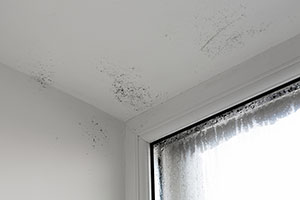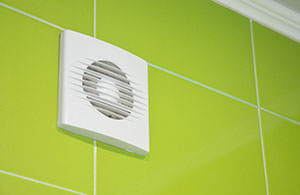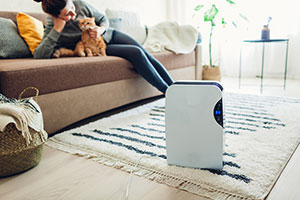When you think about the term ‘home safety’, air quality usually isn’t the first thing to spring to mind. These days, we’re so concerned about our homes being burglar-proof and heating-efficient that the quality of the air we’re trapping inside is at the very back of our minds, if at all. But humidity is dangerous to the health of your tenants, the life of your homes, and the furnishings and belongings inside, so good ventilation is of the utmost importance.
Air moisture will occur regardless of preventative methods. By simply breathing, a sleeping person adds a half pint of water to the air, and twice as much when they’re awake. Property moisture isn’t a curable problem, but it is definitely a treatable one.
Problems:
Condensation:
This is the most common cause of moisture in a property, and one of the biggest nuisances. More than half of UK homes suffer from condensation problems. Condensation can destroy wallpaper, paint and plasterwork, and are a breeding ground for mould - whether you can see it or not.
Water vapour is produced from cooking, washing, drying clothes, and even breathing. It is impossible to tackle condensation completely, but you can, and should, aim to reduce it.
Stale air:
Without proper airflow, being indoors can become stuffy and uncomfortable. Humid environments welcome dust mites and mould spores, making it difficult to breathe. As unlikely as it sounds, opening windows and doors can actually help to efficiently heat your home, as warm air is replaced by cool, dry air, allowing a decent airflow to regulate temperature.
 Damp:
Damp:
Damp is not the same as condensation, and comes in two forms: penetrating and rising. Penetrating damp comes in through the walls or roof through faults in the property’s structure such as cracks. Rising damp comes up through the floor if the damp proof barrier of a house is ineffective. You should be especially alert to issues of damp if you own older houses, as any leaks, cracks, or poorly fitted fixtures can cause or make damp worse.
Illness:
Poor air quality can cause respiratory problems for residents, especially if they are already more at risk (e.g. elderly, children, or already have existing health problems). Moisture and mould allergens can trigger asthma attacks, allergic reactions, skin rashes, and even more serious health issues.
According to studies by myhealthmyhome.com, 81% of people are at risk of suffering from respiratory or dermatological conditions because of the air quality of their home. 15.3 million homes in the UK are at risk of ‘Toxic Home Syndrome’, meaning residents may be exposed to mould, natural radioactive gases, carbon monoxide, and many more. Many of these can be significantly reduced with the right treatment and ventilation.
Solutions:
Many of the measures for effectively ventilating your property will be left to the tenants. For instance, they should open windows, cover saucepans with lids, and use extractor fans when cooking. However, whilst asking tenants to open windows and doors is something of a solution, it is unfair to rely on this method alone during the colder months. Similarly, using low central heating regularly will also help with condensation issues, but you can’t demand that they have the heating on all of the time.
Here are some more permanent solutions you can put in place to help your tenants:
Extractor fans in wetter rooms:
Kitchens and bathrooms are most at risk of mould and condensation.Installing extractor fans will draw damp air out of the room when your tenants are cooking or showering.
Well-ventilating your properties from the beginning means reducing additional costs later down the line, when mould needs removing and rooms need redecorating and furnishings need replacing.
Window fans and vents:
Trickle vents are fitted above windows to reduce condensation and increase ventilation. These can be opened into several positions to minimise any draught whilst still letting the fresh air in.
Window fans can be used to pull in fresh air from outside or exhaust stale air from indoors. They reduce energy costs and can be installed quickly. However, they cannot be used in poor weather conditions, and some may think they look unsightly.
Attic vents:
Without ventilation in an attic, the stagnant air can penetrate the rooms beneath it through the floor.
Positive Input Ventilation (PIV) is a system usually placed in the attic of a property. It continuously supplies fresh and filtered air into the home by diluting, displacing and replacing moist and unpleasant air. This can reduce or eliminate condensation and external pollutants, as well as filter out toxic gases like radon and carbon monoxide.
Juice Electrical Supplies sell affordable PIVs by Nuaire to help combat damp, condensation, and mould.
Ventilation control:
Demand controlled ventilation (DCV) automatically adjusts ventilation equipment to combat changes in humidity or carbon dioxide. Using sensors for both, the ventilation will adapt depending on whether someone has just had a shower, or if there are more people in the house than usual, allowing the air to regulate faster. When air conditions are at an optimum, the vents will shut, minimising any heat loss from the property.
Air conditioners, heaters and dehumidifiers:
Using heaters, air conditioners and dehumidifiers can also be beneficial when trying to reduce condensation, but will cost more energy and money than the previously mentioned solutions. This equipment is particularly useful for drying clothes indoors during poor weather conditions.
The house:
Ensuring that your properties are properly insulated and ventilated will help your tenants to take care of them. This includes double or triple glazing, loft insulation, and cavity wall insulation. Be aware of any issues with leaks or cracks in a property that may need fixing. The sooner they’re sorted, the more additional damage you avoid, and the better your houses are sealed, the easier it will be to manage ventilation.
As a home provider, it is your duty to create a liveable environment for your tenants. Air quality is easy to neglect because you can’t always see its effects. Both yourself and the tenants should want to maintain the quality of your properties, so give them a head start by properly insulating and ventilating their new home.
- Log in to post comments















